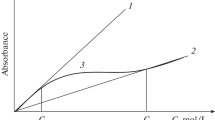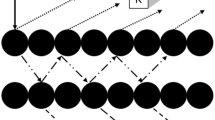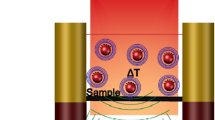Abstract
When the monochromatic light passes through a random attenuating medium, the radiant intensity drops exponentially with the length of the path and attenuation coefficient. The law of exponential decay was called the law of Bouguer, Lambert, Beer or some combination of these three. Here we refer to it as the modified Beer–Lambert law due to the arrangement proposed in the current work. This work aims to use UV–Vis spectroscopy and apply Beer–Lambert law; the feasibility of the work is assessed and shows the possibility of validating a beam intensity measurement experiment in two experimental situations with a known constant. The empirical part of the work consists of changes in chemical or physical properties. The first experimental situation consists of the variation of the concentration of the medium and evaluates the absorption of the laser beam. In this situation is used industrial synthetic dye. The second experiment also assessed the absorption of laser intensity, using variations of the number of films poly (ethylene terephthalate) polymeric sums found in the PET bottle. The values found for constant were ≈ 2.697 in the variation of concentration of synthetic dye in blue color, and for the condition of PET, films were found and ≈ 2.699. The value of the constant experimentally found approaches the Euler number. And they are so, proving that the Euler number can be determined experimentally in a system of Markovian non-interagent particles and how to experimentally validate a result by the association of a constant known in the literature.







Similar content being viewed by others
Data availability
The data sets analyzed during the current study are available from the corresponding author upon reasonable request.
References
V Mosorov Appl. Radiat. Isot. 128 1 (2017)
D F Swinehart J. Chem. Educ. 39 333 (1962)
B Commoner and D Lipkin Science 110 41 (1949)
L Wind and W W Szymanski Meas. Sci. Technol. 13 270 (2002)
K C Harper, E G Moschetta and S V Bordawekar Sci. 5 109 (2019)
A Jubran Crit. Care (2015)
T Winzer et al. Appl. Phys. Lett. 101 (2012)
P Stern Principles of learning and behavior change (2009)
W Mäntele and E Deniz Spectrochim. Acta - Part A Mol. Biomol. Spectrosc. 173 965 (2017)
I Oshina and J Spigulis J. Biomed. Opt. 26 1 (2021)
T G Mayerhöfer, S Pahlow, and J Popp ChemPhysChem (2020)
B Peeters and G De Roeck J. Dyn. Syst. Meas. Control. Trans. ASME 123 659 (2001)
R S Society 50 105 (1988)
G Jamali, S S Sana, and R Moghdani RAIRO - Oper. Res. (2018)
Y Sun and M Kumar AIAA Guid. Navig. Control Conf. 2012 (2012)
S Cannon, J J Daymude, D Randall, and A W Richa Proc. Annu. ACM Symp. Princ. Distrib. Comput. 25–28-July 279 (2016)
Z Yu and X Wen Int. Biodeterior. Biodegrad. 56 109 (2005)
D Jacquemin, E A Perpete and I Ciofini Chem. Res. 42 326 (2009)
M Pávai, T Szabó, and A Paszternák Cellulose 22 1883 (2015)
V Sharma and H T McKone J. Chem. Educ. 88 24 (2011)
I Himri et al. Int. J. Pharm. Pharm. Sci. (2011)
W Romão, M A S Spinacé, and M A De Paoli Polimeros (2009)
I Feder, H Duadi, T Dreifuss, and D Fixler J. Biophotonics (2016)
C Song, J Xu, Y Chen, L Zhang, Y Lu, and Z Qing Molecules (2019)
W Mäntele and E Deniz Spectrochim. Acta - Part A Mol. Biomol. Spectrosc. (2017)
T G Mayerhöfer, S Pahlow, and J Popp Chemphyschem 21 2029 (2020)
V TWERSKY J. Opt. Soc. Am. (1962)
K H Pilehrood and T H Pilehrood Math. Inequalities Appl. (2010)
L S Pedroso, J A de Macêdo and M S T de Araújo Bras. Ensino Fis. 38 1 (2016)
A M Nuijs and J J L Horikx Appl. Opt. 33 4058 (1994)
K Uludag, M Kohl, J Steinbrink and H Obrig J. Biomed. Opt. 7 51 (2002)
N M Anderson and Paul Sekelj Phys. Med. Biol. 12 173 (1967)
N L Swanson and B D Billard Opt. 38 5887 (1999)
M Shimada, Y Masuda, Y Yamada, M Itoh, M Takahash12, and T Yataga11 EXplanation of Human Skin Color by Multiple Llnear Regresslon AnalyslS Based on the Modified Lalnbert-Beer LaW (2000)
S R Adke and S R Deshmukh J. R. Stat. Soc. Ser. B (1988)
C H Wu and H W Chang J. Hazard. Mater. 137 336 (2006)
Acknowledgements
I would like to thank the Federal University of Piauí for the laboratory support, the CNPq for the financial help and the materials and the bionanotechnology group. And ADF would like to thank FAPERJ for the postdoctoral fellowship.
Funding
Funding was provided by Coordenação de Aperfeiçoamento de Pessoal de Nível Superior
Author information
Authors and Affiliations
Corresponding author
Ethics declarations
Conflict of interest
The authors have no relevant financial or non-financial interests to disclose.
Additional information
Publisher's Note
Springer Nature remains neutral with regard to jurisdictional claims in published maps and institutional affiliations.
Rights and permissions
Springer Nature or its licensor (e.g. a society or other partner) holds exclusive rights to this article under a publishing agreement with the author(s) or other rightsholder(s); author self-archiving of the accepted manuscript version of this article is solely governed by the terms of such publishing agreement and applicable law.
About this article
Cite this article
Sinimbu, L.I.M., Carvalho, T.C.V., De Falco, A. et al. Using the Beer–Lambert law to determine the Euler number using a Markovian system. Indian J Phys 98, 1833–1842 (2024). https://doi.org/10.1007/s12648-023-02953-z
Received:
Accepted:
Published:
Issue Date:
DOI: https://doi.org/10.1007/s12648-023-02953-z




